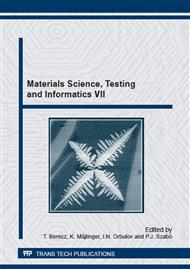p.327
p.333
p.339
p.345
p.351
p.357
p.363
p.369
p.375
Testing of Power Plant Steel Deterioration by Adaptive Nonlinear Harmonics Method (ANLH)
Abstract:
Nowadays, there is increasing importance of the remaining life time estimation of engineering structures. In this work the thermal fatigue process induced deterioration of the three different power plant steels was investigated. The tested steels are widely used as steam pipeline base material of power plants. The applied thermal fatigue test can model the material degradation due to long term service in high temperature environment. In this paper a new high sensitivity magnetic measuring technique is presented called Adaptive Nonlinear Harmonic (ANLH) method. The sensitivity of this measurement is optimized for controlling the thermal fatigue deterioration. The presented novel measurement was developed for non-destructive testing of pipelines and pressure vessels of power plants.
Info:
Periodical:
Pages:
351-356
Citation:
Online since:
February 2015
Authors:
Price:
Сopyright:
© 2015 Trans Tech Publications Ltd. All Rights Reserved
Share:
Citation:


